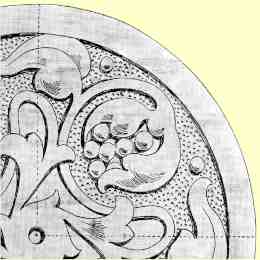The rise of Continental Furniture Design
In my previous article on the decline of Art Nouveau, I discussed the distinction between the style in France and its manifestation in other continental countries. I emphasized that the naturalesque has been the predominant element in France, while other countries have favored adaptations of nature.
Introduction
Furniture design has always been an essential part of human life, serving both functional and aesthetic purposes. Throughout history, furniture has evolved with changing trends and cultural influences, leading to the creation of various styles and designs. One of the most significant movements in furniture design was the emergence of continental furniture design, which started in Europe in the 17th century and lasted until the mid-20th century. Continental furniture design refers to furniture created in continental Europe, primarily in France, Italy, and Spain, and encompasses a wide range of styles, including Baroque, Rococo, Neoclassical, and Art Nouveau.
Continental furniture design is a fascinating topic that offers a glimpse into the rich history and cultural heritage of Europe. It reflects the different artistic movements and social trends of the time, showcasing the creativity and craftsmanship of the designers and artisans who created these pieces. Understanding continental furniture design allows us to appreciate the intricate details and unique features of these pieces and gain insights into the cultural and societal values of the time. Moreover, with the resurgence of interest in vintage and antique furniture, knowledge of continental furniture design is essential for collectors, interior designers, and furniture enthusiasts alike. In this article, we will explore the history and characteristics of continental furniture design, and examine some of the most significant styles and designers that shaped this movement.




Changing Furniture Styles
In the late 19th and early 20th century, there was a trend in England towards furniture designs that were heavily influenced by Continental styles, particularly those from France and Germany. This trend was part of a larger cultural movement that was taking place in England at the time, known as the Aesthetic Movement.
The Aesthetic Movement was an artistic and cultural movement that emerged in the 1870s and 1880s in response to the mass-produced, industrial-style furniture and decorative objects that were becoming increasingly common. Proponents of the Aesthetic Movement believed that art and design should be focused on beauty and craftsmanship, rather than utility. They looked to the past for inspiration, particularly to the art and design of other cultures, such as those of Japan and the Middle East.
One of the most significant influences on the Aesthetic Movement was Continental design, particularly the furniture and decorative arts of France and Germany. These styles were seen as more refined and elegant than the heavy, ornate furniture that was popular in England at the time. As a result, many English furniture makers and designers began to create pieces that were heavily influenced by Continental styles.
The trend for continental furniture designs was especially popular in the high-end market, where it was used to decorate country houses and upper-class homes. The use of these continental designs helped to create a more sophisticated and cosmopolitan atmosphere, and it was seen as a way for the English to assert their cultural and social superiority over their continental counterparts.
This trend of continental furniture designs for the English house started to decline around the turn of the 20th century, as new styles and movements such as Art Nouveau and Arts and Crafts movement emerged.
The Distinction Between Continental and French Art Nouveau
The distinction between Continental and French Art Nouveau is an important one when examining the evolution of furniture design during the late 19th and early 20th centuries. While both movements share similarities in their rejection of traditional design elements and embrace of natural forms, there are notable differences between the two.
One of the main differences between French and other Continental Art Nouveau movements is the use of naturalism in design. In French Art Nouveau, there was a heavy emphasis on the naturalesque element, which sought to reproduce nature as closely as possible. This can be seen in the furniture designs of French artists such as Emile Gallé and Louis Majorelle, who were renowned for their intricate floral motifs and use of materials like stained glass and marquetry.
In contrast, other Continental countries such as Germany and Austria-Hungary placed less emphasis on naturalism and instead favored conventionalization in art. This preference for adaptations of nature rather than strict reproduction allowed for more stylized and abstract designs, which in turn led to a wider range of artistic expression. This can be seen in the works of designers such as Peter Behrens and Koloman Moser, whose furniture designs were characterized by bold geometric shapes and abstract patterns.
Interestingly, the artistic success of the great Latin countries - France and Italy - can be attributed to their ability to create styles with little to no naturalesque element. In these countries, furniture designers were able to develop new forms and styles without being restricted by the need to replicate nature. This allowed for more experimentation and innovation, and led to the creation of iconic designs such as the "Tulip" chair by Italian designer Eero Saarinen.
Despite the emphasis on naturalesque elements in French Art Nouveau, French artists who attempted to set out on entirely new lines experienced limited success around the turn of the 20th century. This was in part due to the growing industrialization of the French furniture industry, which made it difficult for individual artists to compete with larger manufacturers. Additionally, many French artists were more interested in the decorative arts than in creating functional furniture pieces, which limited their appeal to a wider audience.
Understanding the distinction between Continental and French Art Nouveau is crucial to understanding the evolution of furniture design during the late 19th and early 20th centuries. While both movements rejected traditional design elements, the heavy emphasis on naturalism in French Art Nouveau set it apart from other Continental movements. This emphasis, while successful in some respects, also limited French artists' ability to experiment and innovate. Ultimately, it was the ability of designers to strike a balance between convention and innovation that allowed for the creation of some of the most iconic furniture designs of the era.

The Success of German Work
German furniture design is characterized by a unique blend of Gothic and natural forms, which have been perfected over centuries of artistic evolution. The historical connection between Teutonic countries and the Gothic style has been one of the defining factors of German furniture design. The intricate ornamentation of Gothic design has closer ties to natural forms than the Renaissance, which emphasized symmetry and proportion.
German furniture designers have succeeded in creating a new form of art that is inspired by nature, but with a necessary amount of conventionalization. The result is a style that is both aesthetically pleasing and functional. German designers have always had a great respect for the reaction which has set in people's taste, and have adapted to changing tastes by adopting more reasonable forms. This adaptability has been one of the keys to German furniture design's success.
German furniture design has always emphasized the use of high-quality materials and fine craftsmanship. The Germans have a long history of excellence in the craft, which has enabled them to produce furniture that is both beautiful and durable. German designers have also been known for their attention to detail, which has made their furniture highly prized by collectors and enthusiasts.
The success of German furniture design can be attributed to its ability to evolve and adapt over time. The Germans have always been open to new ideas and techniques, and have incorporated them into their designs while still retaining their unique aesthetic. This adaptability has allowed German furniture designers to remain relevant and influential in the world of design.
The success of German furniture design can be traced back to its historical connection to the Gothic style, which has influenced the use of natural forms and ornamentation. German designers have succeeded in creating a style that is both aesthetically pleasing and functional, and have always been adaptable to changing tastes and styles. The use of high-quality materials and fine craftsmanship has made German furniture highly prized by collectors and enthusiasts alike.

New Continental Furniture Designs for the English House
In the early 20th century, there was a trend of new continental furniture designs making their way into English houses. One notable example of ornate furniture design was the German "cosy corner" which featured a bookshelf and a comfortable reading sofa. This design was intended to provide a cozy and relaxing space for homeowners to curl up with a good book.
Another example of a new continental furniture design was the modern dining room design created by Messrs. H. C. R. Mackintosh of Glasgow. This design was characterized by its use of bold, bright colors and geometric shapes. The furniture itself was often designed with a minimalist aesthetic, with clean lines and simple shapes.
While some people were drawn to the bold colors and striking designs of these new continental furniture pieces, others found them to be questionable in form. There was a sense that these designs lacked the traditional elegance and refinement that English furniture was known for.
Despite these criticisms, the popularity of new continental furniture designs continued to grow throughout the early 20th century. Many people were drawn to the novelty and modernity of these pieces, and they began to appear in homes across England. While they may have been seen as unconventional at the time, these new designs laid the groundwork for the furniture styles that would come to dominate the 20th century.
Conclusion
In conclusion, we have explored the world of continental furniture design and its impact on the art world. We have discussed the distinction between French Art Nouveau and other continental styles, the success of German furniture work, and new continental designs for the English house. Throughout our exploration, we have witnessed the beauty, craftsmanship, and timeless appeal of continental furniture design.
It is no wonder that this type of furniture continues to be popular among collectors and interior designers alike. The intricate designs and attention to detail are truly remarkable and leave a lasting impression on those who appreciate the artistry.
As for the future direction of furniture design, we can only imagine what new styles and techniques will be developed. Perhaps we will see a return to more traditional forms and styles, or maybe we will witness a fusion of different cultural influences. One thing is for sure, continental furniture design will always be a source of inspiration and admiration for those who appreciate the beauty of art in everyday life.



